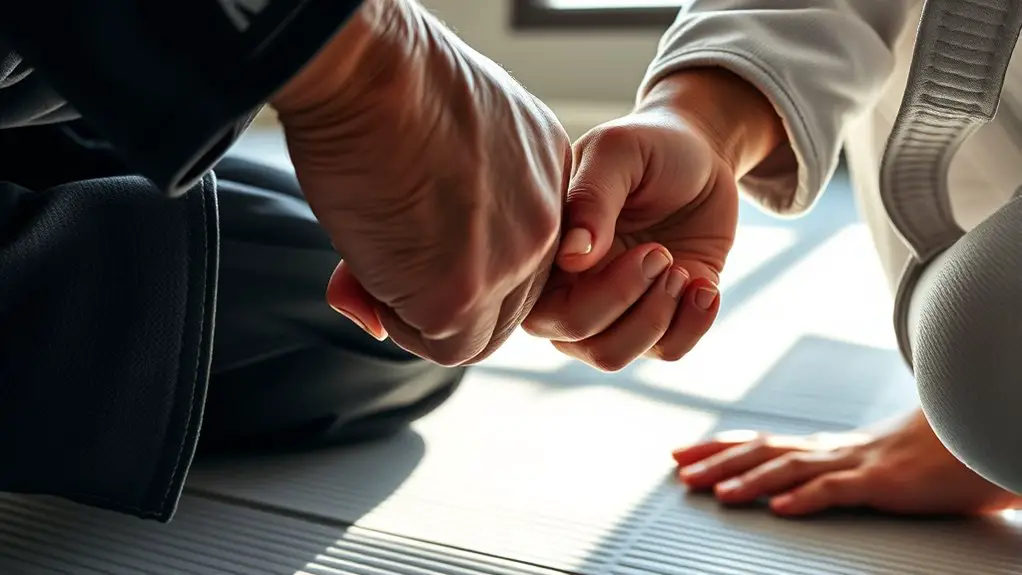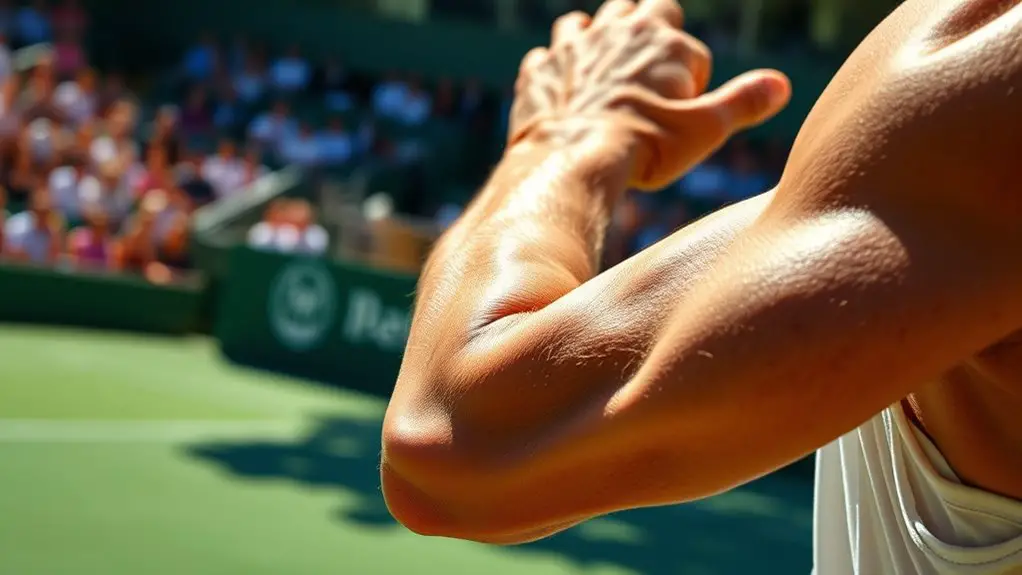Rotational training is essential for golfers like you, as it enhances swing power and accuracy while preventing injuries. By engaging your hips, shoulders, and core effectively, you can improve your game and boost your distance. It builds flexibility and rotational strength, leading to smoother swings. Additionally, focusing on key muscle groups helps refine technique. Want to discover specific exercises and drills to maximize your rotational training? There's much more to uncover to elevate your performance.
Understanding Rotational Movements in Golf
When you swing a golf club, understanding rotational movements is essential for maximizing your performance. Your body isn't just a straight line; it's a flexible, dynamic machine. The power of your swing comes from a combination of your hips, shoulders, and core working together in a fluid motion. Think of it as a dance, where each part of your body moves in harmony, creating a rhythm that enhances your shot.
As you initiate your backswing, your hips should rotate away from the target, storing energy. When you shift to your downswing, you'll release that energy by rotating your hips toward the target. This rotational movement creates torque, which translates into speed and distance. Embracing these movements not only improves your swing but also gives you the freedom to express your unique style on the course. So, let your body flow, and watch how that freedom transforms your game.
The Benefits of Rotational Training for Golf Performance
While many golfers focus on strength training, incorporating rotational training can greatly enhance your performance on the course. By improving your rotational movement, you'll gain the freedom to hit longer drives and achieve more consistent shots. This training helps you harness the power generated through your core, allowing for a smoother swing.
Here are some key benefits of rotational training:
- Increased Power: Engaging your core improves the force you can generate during your swing.
- Better Accuracy: Enhanced rotation leads to more precise shot placement, giving you better control over your ball.
- Improved Flexibility: Rotational exercises promote a greater range of motion, essential for fluid movement throughout your game.
Embracing rotational training not only refines your technique but also frees your potential on the course. So, why not give it a shot?
How Rotational Training Prevents Injuries
Incorporating rotational training into your routine not only boosts performance but also plays a crucial role in injury prevention. By enhancing your body's ability to rotate efficiently, you reduce the risk of strains and sprains that often arise from improper mechanics. When your muscles, ligaments, and joints work harmoniously, you're less likely to overexert any single area, which can lead to injuries.
Rotational training strengthens the core and stabilizes the spine, allowing for smoother swings and better balance. This stability is essential in golf, where explosive movements can easily lead to wear and tear if your body isn't prepared. Plus, by improving your range of motion, you're less likely to force your body into awkward positions during your swing. Additionally, incorporating flexibility training can enhance joint fluidity, further reducing the risk of injuries during your game.
Ultimately, prioritizing rotational training empowers you to play freely and confidently, knowing you're not just avoiding injuries but also enhancing your game. Embrace this training, and let your body thrive on the course!
Key Muscles Involved in Golf Rotation
Understanding the key muscles involved in golf rotation is essential for improving your swing and overall performance. When you harness the right muscle groups, you'll gain more power and accuracy in your shots.
Focus on these key muscles:
- Core Muscles: Your abs and obliques stabilize your torso during the swing, allowing for better control. Developing a strong core enhances movement efficiency, which is crucial for a powerful swing.
- Glutes: Strong glutes support your hips and provide stability, enhancing your rotational power.
- Shoulders: Flexibility and strength in your shoulder muscles help you achieve a full, fluid swing.
Exercises to Incorporate Rotational Training
To enhance your golf swing, incorporating specific exercises that target the key muscles involved in rotation can make a significant difference. Start with torso twists; standing with your feet shoulder-width apart, rotate your upper body side to side while keeping your hips stable. This will help improve your rotational mobility. Next, try medicine ball slams. Raise the ball overhead and slam it down to one side, engaging your core and promoting explosive rotational strength.
Don't forget about the cable woodchop. Using a cable machine, pull the handle down and across your body in a chopping motion to strengthen your obliques. Finally, practice the bird dog exercise. On all fours, extend one arm and the opposite leg, maintaining stability and balance, which promotes coordination in your swing. Incorporating these exercises will empower your game, helping you swing freely and fluidly on the course.
The Role of Core Strength in Rotational Movements
Core strength is essential for effective rotational movements in your golf swing. It not only enhances your swing mechanics but also helps in preventing injuries on the course. By focusing on building a strong core, you can improve your overall performance and enjoy the game more.
Core Strength Essentials
Strength is the foundation of effective rotational movements in golf, and enhancing your core can greatly improve your swing. A strong core stabilizes your body during those powerful rotational motions, allowing for greater control and precision. When your core's engaged, you'll find freedom in your swing, leading to improved performance on the course.
Consider these core strength essentials:
- Improved Balance: A strong core helps maintain stability, reducing the risk of injury.
- Increased Power: Core strength translates into more powerful swings, boosting your distance.
- Enhanced Flexibility: A strong, flexible core allows for smoother, more fluid rotational movements.
Impact on Swing Mechanics
While it may seem like the arms and wrists are the primary drivers of a golf swing, the truth is that your core plays a pivotal role in swing mechanics. A strong core stabilizes your body, allowing for efficient rotational movements. When you engage your core, you create a powerful foundation that drives your swing, enhancing speed and accuracy. By focusing on rotational training, you'll learn to harness that strength, enabling your hips and shoulders to work in harmony. This synergy not only improves your swing path but also allows for a smoother shift throughout your swing. Ultimately, when your core is strong, you'll experience more freedom in your movements, leading to better performance on the course.
Injury Prevention Benefits
When you prioritize rotational training, you'll not only improve your swing but also greatly reduce the risk of injuries. By focusing on core strength, you're setting yourself up for a more stable and powerful game. A strong core supports your spine during those demanding rotational movements, helping to prevent strains and sprains.
Here are some key benefits of core strength in injury prevention:
- Enhanced Stability: A strong core keeps your body aligned, minimizing the risk of awkward movements.
- Improved Balance: Better balance helps you maintain control throughout your swing, reducing the chance of falls or missteps.
- Increased Flexibility: A flexible core allows for a greater range of motion, which can protect against overexertion.
Embrace rotational training, and enjoy a healthier, more liberated golfing experience!
Integrating Rotational Training Into Your Practice Routine
Integrating rotational training into your practice routine can considerably enhance your performance on the course. You'll not only improve your core strength but also develop more powerful swings through specific exercises and drills. Let's explore some effective rotational exercises and how to incorporate them seamlessly into your training sessions.
Benefits of Rotational Exercises
Rotational exercises can greatly enhance your golf game by improving your swing mechanics and overall power. By incorporating these movements into your routine, you'll experience greater freedom in your swings and the ability to release your full potential on the course. Here are some key benefits:
- Increased Power: Stronger rotational muscles lead to more explosive swings.
- Improved Flexibility: Enhanced range of motion helps you maintain a fluid swing.
- Better Balance: Strong core stability supports better weight transfer and control.
Embracing rotational training not only boosts your performance but also adds enjoyment to your practice. You'll feel more connected to your body and free to express your unique swing style, making every round a thrilling adventure.
Sample Training Drills
To maximize the benefits of rotational exercises, incorporating specific drills into your practice routine is key. Start with the medicine ball twist: hold a medicine ball at chest level, rotate your torso side to side, feeling the core engage. Next, try the rotational swing drill; use a golf club, practice your swing while focusing on your hip rotation without hitting a ball. This builds muscle memory and enhances your range of motion. Finally, consider the standing cable rotation; use a resistance band or cable machine, pulling across your body to strengthen your rotational muscles. By consistently integrating these drills, you'll enhance your power and flexibility, giving you the freedom to release your best swing on the course. Enjoy the journey!
Measuring Progress in Rotational Training
Measuring progress in rotational training is essential for golfers aiming to enhance their swing mechanics and overall performance. By tracking your improvements, you can identify what works and what needs adjustment. Here are three effective ways to gauge your progress:
- Video Analysis: Recording your swings allows you to visually compare your technique over time, spotting areas for refinement.
- Performance Metrics: Keeping track of statistics like drive distance and accuracy can show how your rotational skills translate into on-course success.
- Flexibility Assessments: Regularly testing your range of motion can help you understand how your body adapts to rotational exercises, ensuring you're staying loose and ready.
Tips for Staying Consistent With Rotational Exercises
Staying consistent with your rotational exercises can be challenging, especially when balancing a busy schedule and other commitments. To make it easier, try carving out specific times in your week dedicated solely to these workouts. Treat them like important appointments you can't miss.
Another great tip is to keep your exercises varied and fun. Mix in different drills to keep things fresh—this'll not only maintain your interest but also target various muscle groups.
You can also set small, achievable goals to track your progress and celebrate each milestone. This sense of accomplishment will motivate you to stick with it. Incorporating multi-joint exercises can also enhance your routine by mimicking real-life movements and improving functional strength.
Lastly, consider finding a training buddy. Having someone to share the journey with can make it more enjoyable and hold you accountable. Embrace the freedom of movement and improvement—your golf game will thank you for it!
Frequently Asked Questions
How Often Should I Incorporate Rotational Training Into My Weekly Routine?
You should incorporate rotational training into your routine at least two to three times a week. This frequency helps enhance your overall strength and mobility, giving you the freedom to move more efficiently in your activities.
Can Beginners Benefit From Rotational Training in Golf?
Absolutely, you can thrive in golf with rotational training! While some might shy away, embracing this practice releases your potential, granting you freedom in your swing. So, don't hesitate—start incorporating it for smoother, more powerful shots!
What Equipment Is Recommended for Rotational Training Exercises?
For rotational training, you'll want a stability ball, resistance bands, and medicine balls. These tools help enhance your core strength and flexibility, allowing you to enjoy a more dynamic and effective workout experience.
How Long Does It Take to See Results From Rotational Training?
You'll typically start seeing results from rotational training within a few weeks, but it depends on your consistency and effort. Stick with it, and you'll notice improvements in strength and flexibility over time.
Are There Any Age Restrictions for Practicing Rotational Training in Golf?
Age is just a number, and anyone can practice rotational training in golf. Whether you're young or seasoned, this training can enhance your swing. So, don't hesitate to embrace the freedom of movement at any age!




